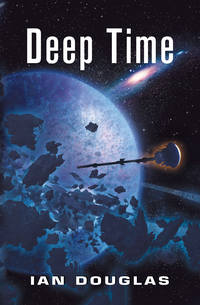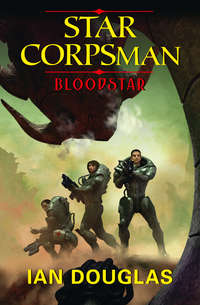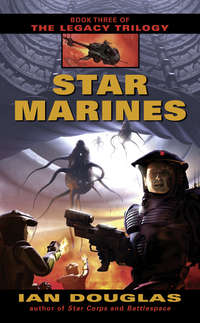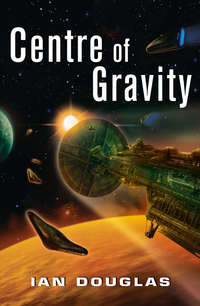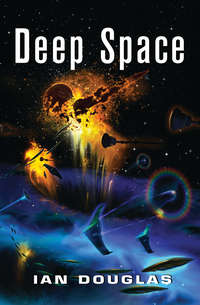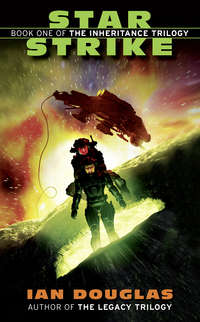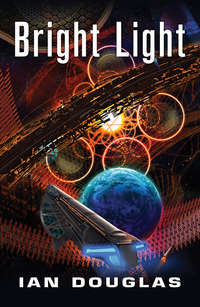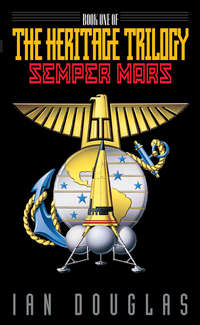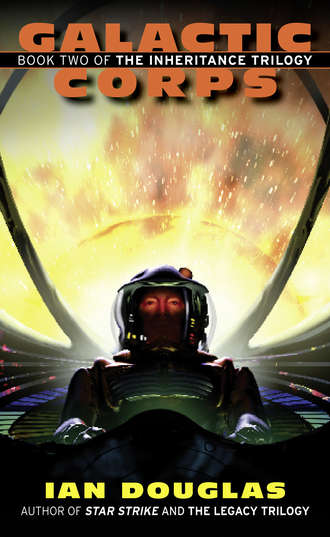
Полная версия
Galactic Corps
Garroway felt the sharp jolt as magnetic grapples released his bottle, and then the Ishtar’s ventral hull was receding against the stars. From his perspective, it appeared that the transport had suddenly begun accelerating away from him; in fact, Ishtar had just halted its gateward drift, allowing a cloud of M-CAPs to emerge from her belly and continue drifting toward the gate at a steady kilometer per second.
M-CAPs, Marine Combat Assault Pods, were only the most recent means of transporting individual Marines into battlespace, an upgrade to the Space Assault Pods, or SAPs in wide use until only a few years ago. Somewhere between a very large, bulky, and powerful unit of heavily armed space armor and a very tiny, lightly armed, underpowered one-man space craft, a CAP carried a single Marine within its claustrophobic core. A gravitic drive allowed the device to accelerate at forty gravities—about four hundred meters per second per second. It responded directly to a Marine’s thoughts, through his cereblink, and provided him with constantly updated information on his surroundings and the tactical situation.
For self-evident reasons, Marines called them bottles, among other nastier, more vitriolic names.
“Okay, people,” Blackjack’s voice told them over the Net. “We’re doing this by the book. We want to maintain the element of surprise for as long as possible, so do not engage your gravitics until I give the word. Power at ten percent only. Magnetic shielding engaged. Optical benders on. Everyone copy?”
A chorus of voices came back over the Net, mingled calls of “aye, aye, sir” and “copy that” and “ooh-rah.” A display open to one side within Garroway’s mind showed the telemetry from each pod, all green and go.
The assault force, one hundred fifty Marines of Bravo Company, First Marine Assault Battalion of the First Marine Interstellar Expeditionary Force was going to war.
Falling … falling … the bottles drifted into the opening of the stargate unpowered, with just enough power trickling through their drives to keep them from running afoul of one another, and to keep the magnetic shields charged and ready. Around them, unseen within the distant rim of the gate, a pair of Jupiter-massed black holes circled along their ancient tracks in opposite directions, at a velocity approaching that of light. The stresses on local spacetime were somehow—the technology was still well beyond the capability of human physics—focused at the gate’s lumen. The frequency of those rotating singularities had already been tuned to connect this gate with one particular other gate … one some twenty thousand light years above the plane of the Galaxy.
For the briefest of instants, Garroway felt the sharp, inner twist of tidal forces, and then he was through.
The sky wavered … shimmered … then blinked.
And he was somewhere else, somewhere … astonishingly else.
Not for the first time, Garroway wondered why you couldn’t see through an open gate to the other side, or why radio or lasercom signals could not be passed through, while solid things like starships made the passage almost unimpeded. The physicists said that had to do with a kind of flicker or stutter effect due to the period of the rotating singularities that allowed mass through in discrete, quantum chunks, but which interfered with the wave aspect of energy. Even so, he’d once seen the flash from a nova pass through an open gate, and do so with power enough to destroy a Xul huntership.
So much Humankind had yet to learn.
He looked around, studying ambient space with all the rubbernecking fervor of a first-time tourist in EarthRing City. An ancestor of Garroway’s had been here once, centuries before. The place was known as Cluster Space, and it was located, so far as AI navigational programs could place it, some twenty to twenty-two thousand light years above the plane of the Galaxy, and at least thirty thousand light years from Earth.
From out here, of course, the microscopic yellow speck of Earth’s sun was quite invisible, utterly lost within the vast and milky swirl of pale light hanging in the sky, a spiral that looked oddly like a pale-colored whirlpool frozen in an instant of time. Most individual stars at this distance were lost; only novae or the very brightest of giant suns were visible as separate stars out here. What remained was a kind of graininess or digital noise to the light. In fact, it looked much like the pale glow from the Milky Way seen on a pellucidly clear, dark night on Earth or, better, Mars … and for an obvious reason. It was the same glow, but seen from the outside against the black emptiness of the intergalactic voice, rather than from within one of the Galaxy’s spiral arms.
Here, the Galaxy stretched across half of the sky, tilted at a slightly oblique angle. Garroway could distinguish the slight differences in hue, blue and blue-white in the spiral arms, reddish in the swollen bulge of the central core. The smear of nebulae, some coal-black, other emission nebulae showing pale glows of green or red, wove among the stars like ragged streamers in an unfelt wind.
Opposite, against the ultimate void of the intergalactic abyss, a solitary globular star cluster hung in isolated splendor, a teeming beehive of suns, spanning a breadth of sky perhaps sixteen times as large as the full moon when seen from Earth, glowing with an almost undetectable reddish hue identical to the ruddy glow of the Galactic Core.
In a different direction lay the local star, a class-M red dwarf visible solely as a bright red spark against the night. That star, catalogued simply as CS-1, but nicknamed Bloodlight by the Marines, was the primary target of the op, which had been tagged Clusterstrike by the mission planners.
Behind the Marines was the stargate … but not the gate into which Bravo Company had just fallen. The tidal stresses of the gate back in Carson Space had linked across the light millennia with the gate here, allowing the swarm of Marine bottles to come through, gate-to-gate.
A flood of radio-frequency noise washed through his bottle’s exposed sensors, and Garroway set his personal AI to screening it, sifting through for hard data on enemy positions. The enemy was here. Humankind’s ancient enemy, the Xul …
Among other threats, a trio of Xul fortresses orbited here, only a few hundred kilometers away, and those fortresses had to be eliminated if Clusterstrike was to succeed. Trans-gate probes had already slipped through and located each of the three, along with every other enemy ship and station within this system. Those probes had managed to return, apparently unnoticed, but Marine bottles were larger and noisier than AI probes, and they were in this instant terribly vulnerable to attack.
Unlike the earlier Space Assault Pods, each M-CAP was effectively invisible, the coating of nano covering each one serving as uncounted trillions of optical relays, pulling light from one side of the bottle around to a carefully calculated point on the opposite side before releasing it. The effect was to make the bottle almost invisible so that light, radar, and other radiation was curved past the bottle rather than reflecting from it—optical bending. The various patches in each bottle’s hull not shielded by the benders—which allowed the Marines to see out and to communicate with one another and with the company AI net, among other things—were so small they were nearly invisible at any range greater than a few meters.
Still, the illusion was not perfect, and things like radiated heat or the spatial distortion caused by a gravitics drive could cause enough of a ripple against background stars to reveal their presence to a careful and watchful enemy. At Captain Black’s command, and under Smedley’s precise control, the school of invisible fish shifted vector as a unit, moving now slantwise across the opening of the stargate, each platoon angling toward a different target, the three Xul bastions guarding this gateway into Cluster Space.
So far, their entrance appeared to have gone unnoticed.
It would have been a mistake, though, to assume the Xul were careless or less than alert. Intelligence had reported that their defenses had been tightening up at all of their known gate outposts over the past few years, as the Xul Mind as a whole began, slowly, to react to Humankind’s attacks.
For almost nine years, now, 1MIEF had been playing a deadly game, one absolutely vital to the survival of Earth and Humankind. With both military and civilian intelligence services certain that the ancient enemy, the Xul, had learned the location of Sol and of the existence of humanity, Lieutenant General Martin Alexander, acclaimed Hero of the Battle of the Nova, had for almost a decade, now, been wielding the 1st Marine Interstellar Expeditionary Force like a personal weapon. Again and again, a Xul bastion outpost, either long-known or newly discovered, would be targeted by 1MIEF for a lightning raid. Usually, the Xul bastion would be located within a system containing one or more of the ancient stargates.
Those gates were still mysteries. Human xenosophontologists and intelligence officers all agreed that the system of stargates scattered throughout the Galaxy and beyond were not, themselves, the product of Xul technology, but were leftovers from some other, much more ancient civilization, now long vanished. But the Xul, like the N’mah and humans, used the gates to their own advantage with other technologies for crossing the long, empty light years. The Gatenet provided a transport web spanning tens of thousands of light years—if you knew where each gate attunement led.
The Xul appeared to be very much at home with the Gatenet, had woven it into the fabric of their empire. Humans were still learning the shape and dimensions of that Net. But one by one, human forces continued to secretly find, note, and then attack every Xul gate outpost they could find. By keeping up a relentless assault, the hope was to keep the Xul preoccupied with tracking down and destroying 1MIEF, rather than with moving into the star systems occupied by Humanity—including Sol—and obliterating them.
Clearly, the Xul could send Humankind into extinction if they set their considerable assets toward that goal; the trick was to keep them so off balance with constant raids, each one a pinprick on its own, that they never got around to that final genocidal thrust at the worlds occupied by humanity.
How long could 1MIEF keep up the pinpricks? No one knew, though the topic was a favorite during off-watch bull sessions in the Marine squad bays on board each of the fleet’s transports. Marine and Navy sim-warriors and armchair generals made elaborate bets as to how long the task force could stay on the offensive, whether or not they’d be recalled to Sol, and how long it would be before the Xul empire collapsed.
Garroway had participated in a few of those sessions, but had refrained from joining in on the betting. If he’d started making wagers, he would have been betting against his own survival … a distinctly uncomfortable position in which to find oneself. He believed in the Marine Corps and in the Corps’ indomitable fighting spirit, but he also knew just how large the Xul presence in the Galaxy must be. Conservative estimates said the Xul hunterships outnumbered all human starships on the order of several tens of thousands to one. The Galaxy was that large.
Not good odds. Not good odds at all.
His bottle was rapidly approaching one of the Xul fortresses now, a massive, squashed sphere five kilometers across. The surface showed a platinum-silver sheen that appeared smoothly reflective from a distance but which, as his M-CAP fell closer, was revealed to be a maze of geometric shapes, angles, protrusions, towers, squared-off valleys, and raised blocks. Weapons ports and turrets revealed themselves everywhere, plasma guns and magnetic accelerators and other weapons that affected the very nature of matter itself—and which were still sheer magic in so far as human technology was concerned.
Smedley announced that they were passing through the first of several magnetic screens. The surface nano on each pod adjusted to let it slip through without disturbing the field and announcing the Marine assault team’s presence. Garroway found he was holding his breath, wondering when something would trigger, when surprise would be lost and the battle would begin. …
M-CAPs were superbly stealthy, as close-to-invisible as modern military technology could make them. Though bottles could accelerate at forty gravities, their approach so far had been deliberately low-key and unobtrusive, too slow for the automated Xul defense systems to recognize a threat.
They hadn’t been seen so far. That, or the Xul targeting sensors already had them locked in, and were simply waiting for the order to fire.
Closer now … fewer than five kilometers. His personal AI took over full control of the small ship, identifying the best place for touch-down, coordinating with the company AI and the other fifty bottles in First Platoon, slowing Garroway’s bottle with precisely timed bursts of its gravitics drive until it was hovering motionless a few meters above the surface. Gently, then, the craft lowered itself against the small but distinct gravitational attraction of the Xul fortress, until the two kissed.
“Contact,” Garroway reported. Within his mental tacsit display, other Marines were reporting a successful touch-down all around him.
According to plan, the Headquarters element had grounded with First Platoon, which had as its target the largest of the three Xul bastions. Second and Third Platoons were deploying to the other two fortresses. Each Marine element was now on its own.
Still under AI control, Garroway’s bottle extended its boarding cutter, a cylinder extruding nano-disassemblers from its business end to eat through the ceramic composites that made up the Xul structure’s hull and create a tightly sealed docking collar. The bottle should be able to eat through the outer layers of armor within a minute or so, allowing Garroway and the other Marines to drop down into the interior of the fortress.
“Incoming bogies!” a shrill voice called over the tactical net. “We’ve got incoming bogies!”
So the Xul had finally adapted to this form of attack. The pods must have triggered some sort of alarm or defensive system as soon as they’d started touching down. On Garroway’s mental tac display, a cloud of red targets was now emerging over the Xul fortress’s close horizon, bearing down on the Marine assault platoon like an angry swarm of bees.
“Perimeter defense!” Captain Black called. “Take ’em down!”
The thirty M-CAPs of First Platoon and the HQ section had set down on the Xul fortress in an AI-controlled pattern, with an outer ring along the perimeter of Marines with heavy weapons, and two inner rings intent on tunneling into the fortress. Garroway snapped on his targeting link, and felt his bottle spin within the boarding collar to bring the target cloud under his weapon.
The AP-840 M-CAP mounted a single weapon at its stern—the part of the bottle opposite the boarding collar, still raised three meters above the Xul hull. After latching on and digging in—“taking a bite,” as Marine slang put it—the M-CAP essentially became a mounted turret weapon. The gun, depending on the mission load-out, could be a V-90 Striker missile launcher, a rapid-fire magnetic pulse gun, or a Starfire plasma weapon.
Garroway’s bottle mounted the V-90. The Striker was a smart weapon that could carry a variety of warheads. The missiles filling Garroway’s ammo bins each were fitted out with ND-4 nanodisassembler pods. Tracking the incoming cloud in his mind, nudging the selector to full auto, he thoughtclicked the firing control and a stream of forty-centimeter missiles snapped from his weapon mount. The missiles coordinated with one another to disperse into the cloud, ignoring the leading elements of the enemy force and detonating deep within the attacking formation.
Each exploding pod released a cloud of its own—millions of molecule-sized nanodisassemblers traveling at high speed and programmed to begin taking apart whatever they happened to strike. Working on an atomic level, they were fast; almost immediately, red-highlighted targets on the tactical display began winking out, as though black cancers were eating through the formation from within, the decay beginning at a dozen different starting points and swiftly working its way out.
Other Marine M-CAPs around the perimeter began firing as well, adding their own clouds of nano-D to the general destruction, or lashing out with man-made bolts of plasma lightning.
Then the cloud reached the Marine perimeter.
Each target was a Xul warrior—a machine, actually, that was apparently grown within the hulls of their hunterships and forts. Two to three meters long, egg-shaped, but with smooth convolutions and bulges, each extruded a number of tentacles at seemingly random points on their shells, each possessed glittering lenses, also randomly positioned over their bodies. Some of those lenses would be eyes. Others …
Laser fire snapped across the outer hull of Garroway’s pod, generating a silvery puff of expanding vapor. Damn! The Xulies weren’t supposed to be able to see the Marine bottles with the optical benders on … but, then, no one was certain what wavelengths the Xul warriors used for vision, or what other senses they might possess.
He snapped off another burst of nano-D in response, but the Xul that had nailed him had already vaporized an instant before, caught by a flash from Sergeant Colby’s plasma gun.
“Thanks!” Garroway called to her over the tactical net.
“Don’t mention it, Gare!” was her response. She was already tracking another Xul warrior, as was Garroway. As the enemy swarmed over the Marine position, he’d switched to single shots and shoot-to-hit; the enemy was widely enough dispersed now that the Marines could no longer wipe out large numbers of the enemy combat machines with area fire. His bottle spun wildly, tracking a Xul as it streaked past low above the surface of the fortress. Garroway held his fire until his targeting cursor tracked past several nearby Marine bottles, then slammed a nano-D pod squarely into the now-fleeing machine from behind. The Xul warrior fell to pieces, a spray of dissolving parts, seconds later.
Local nano-D levels were rising sharply in the immediate battlespace. Drifting motes of disassembler were striking his pod, now, then rebounding. They were programmed to recognize the outer nano coatings of the M-CAPs and ignore them and seek other targets, but a few were beginning to burrow into his bottle at points scoured clean of nano by the Xul laser bursts. The automatic defenses on Garroway’s pod were growing erratic, and would soon fail.
“Smedley!” Garroway called, loosing another barrage at a pair of incoming Xul combat robots. “I’ve got nano-D on my pod, friendly fire! Tell the bastards to go chow down on something else!”
The company AI tweaked the electronics in Garroway’s bottle, and the errant nano-D drifted away into space like a puff of vapor, repelled by the brief, coded signal. A lot of the stuff was starting to work on the Xul fortress’s hull around the bottles, too. That might cause problems later, but there wasn’t much that could be done about it. Modern battlefields tended to soften and sludge down as random traces of nano-D, both friendly and enemy, began to accumulate in the area.
Then there was a sharp jolt, and Garroway’s bottle dropped by a meter, sliding down hard into the boarding collar. The deck he was standing on dilated open. He didn’t immediately fall in the microgravity of the Xul fortress but, setting the pod’s combat initiative on auto, he triggered a pair of battlespace drones, launching them into the emptiness at his feet.
A firefight was raging down there, as other Marines entered the enemy bastion. Garroway’s drones uplinked to his helmet, showing him images of Marines in heavy armor struggling in a low, broad passageway with Xul fighterbots coming at them tentacle to metallic tentacle. He charged his suit’s weapons, then gave a hard shove down through the open deck. Passing through the boarding collar, he entered the fight.
The passageway was two meters tall and ten to twenty wide, and the Marines were forced to stoop slightly because a Marine in Type 664 combat armor stood at nearly two and a quarter meters.
It was a Dantean scene, a circle of Hell, with Marines and Xul fighterbots struggling at knife-fighting range. It looked as though it should be unbearably noisy, but the interior of the Xul fortress was in hard vacuum and each bolt of plasma, each detonating grenade, each ripping or exploding alien shell did so in eerie silence. When Garroway’s boots touched the deck, though, he could feel the noise, a kind of steady, pounding thrum in the bulkheads and deck as the vibrations were transmitted through Xul ceramic to his combat armor.
The one advantage possessed by the Marine assault team was that they were physically shorter than the Xul machines, which, in that low corridor, were coming at them horizontally, pulling themselves along with powerful flicks of their tentacles against the deck and the overhead. As a result, the only weapons the enemy could bring to bear were those set into the tops of their egg-shaped bodies. After a few moments, the Marines, too, began leaning forward, lifting their boots off the deck, dropping prone to minimize their cross-sections as targets as they poured a devastating and concentrated fire into the attacking hordes.
Garroway mounted an MPPG-40 on the right arm of his combat armor, a rapid-fire mass driver on his left. He shouldered forward about twelve meters, taking up a firing position next to Corporal Gerad Kukovitch, a massively built fungie in the company from Spokane, Washington. Kuk was mounting a 20mm full-auto grenade launcher on his suit; he was one of the few people in the company big enough to pack one. The Marine was floating horizontally, taking partial cover behind one of a number of pillar-like structures scattered through that alien hall. They looked like massive, meter-thick bundles of rope or ceramic cabling growing like tree trunks between deck and overhead. Garroway stretched out beside him, firing from the other side of the pillar.
Side by side, the two Marines coordinated their fire, ’Vitch’s grenades silently flashing as they ripped through the enemy ranks, Garroway’s MPPG sending blinding bolts of blue-white energy arcing down the corridor, ripping deep into everything they touched. Sergeant Larissa Colby joined them a second later, adding her plasma weapon to the melee. One by one, other Marines began locking in with the growing phalanx of Marines while their suit AIs linked in with one another under Smedley’s guidance to coordinate their fire.
Together, as a unit, they were far more effective in concentrating their fire.
And then, almost magically, the enemy horde vanished, seeming to melt away into deck, overhead, and the far bulkheads of the chamber.
“Keep alert!” Captain Black called over the company Net. “They’ll be back! Special weapons forward!”
Two Marines moved up the debris-filled space, hauling massive tubes with them. Tripod legs unfolded as they planted the mounts against the deck and activated them.
For some centuries, Marine tactics against Xul ships and bastions had involved boarding the enemy and lugging backpack nukes into the structure’s depths. Nuclear explosions on the outer hull of one of the immense Xul hunterships or the even larger enemy fortresses did little permanent damage, and the resultant craters generally were patched over within a matter of minutes by flying clouds of fist-sized repair robots. A nuke detonating deep inside a Xul ship, though, tended to cause terrible damage, hampered automated repair efforts, and often loosed the microsingularities these monsters used as their power sources, and that was almost always fatal even to the largest Xul ship or structure.




